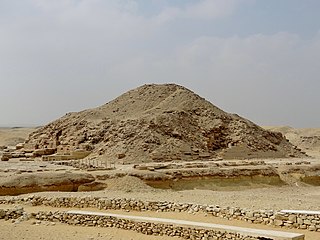
Imhotep was an Egyptian chancellor to the King Djoser, possible architect of Djoser's step pyramid, and high priest of the sun god Ra at Heliopolis. Very little is known of Imhotep as a historical figure, but in the 3,000 years following his death, he was gradually glorified and deified.

Yahweh was an ancient Levantine deity who was venerated in Israel and Judah. Though no consensus exists regarding his origins, scholars generally contend that he is associated with Seir, Edom, Paran and Teman, and later with Canaan. His worship reaches back to at least the Early Iron Age, and likely to the Late Bronze Age, if not somewhat earlier.

Set is a god of deserts, storms, disorder, violence, and foreigners in ancient Egyptian religion. In Ancient Greek, the god's name is given as Sēth. Set had a positive role where he accompanies Ra on his barque to repel Apep (Apophis), the serpent of Chaos. Set had a vital role as a reconciled combatant. He was lord of the Red Land (desert), where he was the balance to Horus' role as lord of the Black Land.

Akhenaten, also spelled Akhenaton or Echnaton, was an ancient Egyptian pharaoh reigning c. 1353–1336 or 1351–1334 BC, the tenth ruler of the Eighteenth Dynasty. Before the fifth year of his reign, he was known as Amenhotep IV.

Atum, sometimes rendered as Atem, Temu, or Tem, is the primordial God in Egyptian mythology from whom all else arose. He created himself and is the father of Shu and Tefnut, the divine couple, who are the ancestors of the other Egyptian deities. Atum is also closely associated with the evening sun. As a primordial god and as the evening sun, Atum has chthonic and underworld connections. Atum was relevant to the ancient Egyptians throughout most of Egypt's history. He is believed to have been present in ideology as early as predynastic times, becoming even more prevalent during the Old Kingdom and continuing to be worshiped through the Middle and New Kingdom, though he becomes overshadowed by Ra around this time.

Shu was one of the primordial Egyptian gods, spouse and brother to the goddess Tefnut, and one of the nine deities of the Ennead of the Heliopolis cosmogony. He was the god of light, peace, lions, air, and wind.
Sobek, Coptic: Ⲥⲟⲩⲕ, romanized: Souk), also known as Suchus, was an ancient Egyptian deity with a complex and elastic history and nature. He is associated with the sacred and Nile crocodiles and is often represented as a crocodile-headed humanoid, if not as a crocodile outright. Sobek was also associated with pharaonic power, fertility, and military prowess, but served additionally as a protective deity with apotropaic qualities, invoked especially for protecting others from the dangers presented by the Nile. A fossil of a Spinosaurus at the Field Museum in Chicago is named after this god.

Iah is a lunar deity in ancient Egyptian religion. The word jꜥḥ simply means "Moon". It is also transcribed as Yah, Jah, Aa, or Aah.

Menhit was originally a Nubian lion goddess of war in the Kingdom of Kush, who was regarded as a tutelary and sun goddess. Her name means either "she who sacrifices" or "she who massacres."

Ash or Yuc was an Amazigh sky god worshipped by the Libyan and Tehenu tribes of the Western Desert, an area of desert that lies west of the Nile River. He was regarded as the "Lord of the Tehenu" by the Ancient Egyptians.

The Second Dynasty of ancient Egypt is the latter of the two dynasties of the Egyptian Archaic Period, when the seat of government was centred at Thinis. It is most known for its last ruler, Khasekhemwy, but is otherwise one of the most obscure periods in Egyptian history.

Hu, in ancient Egypt, was "the personification of a religious term, the 'creative utterance'" and closely connected to Sia. Hu was deification of the first word, the word of creation, that Atum was said to have exclaimed upon ejaculating in his masturbatory act of creating the Ennead.

The Fifth Dynasty of ancient Egypt is often combined with Dynasties III, IV and VI under the group title the Old Kingdom. The Fifth Dynasty pharaohs reigned for approximately 150 years, from the early 25th century BC until the mid 24th century BC.

Neferkauhor Khuwihapi was an ancient Egyptian pharaoh of the Eighth Dynasty during the early First Intermediate Period, at a time when Egypt was possibly divided between several polities. Neferkauhor was the sixteenth and penultimate king of the Eighth Dynasty and as such would have ruled over the Memphite region. Neferkauhor reigned for little over 2 years and is one of the best attested kings of this period with eight of his decrees surviving in fragmentary condition to this day.

Geb, also known as Ceb, was the Egyptian god of the Earth and a mythological member of the Ennead of Heliopolis. He could also be considered a father of snakes. It was believed in ancient Egypt that Geb's laughter created earthquakes and that he allowed crops to grow.

Maatkare B was a wife of pharaoh Osorkon I and the mother of the High Priest of Amun Shoshenq C. Maatkare was the daughter of Psusennes II.

Sebiumeker was a major supreme god of procreation and fertility in Nubian mythology who was primarily worshipped in Meroe, Kush, in present-day Sudan. He is sometimes thought of as a guardian of gateways as his statues are sometimes found near doorways. He has many similarities with Atum, but has Nubian characteristics, and is also considered the god of agriculture.

Sedjem (sḏm) was an ancient Egyptian god who, along with Irer, join Hu and Sia as creative powers of the gods. Sedjem, which literally translates to "hearing," first appeared as a scribe for Thoth and Seshat in the temples of Seti I and Ramesses II at Abydos.


















